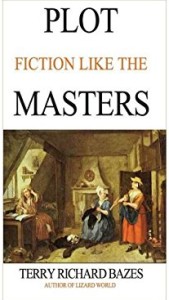Plot Fiction Like the Masters is a small book that teaches you a lot. Especially about writing novels, particularly the kind that will make you immortal in the annals of literature.
Terry Bazes is a graduate of Columbia College and has a PhD. in English Literature from the State University of New York at Stony Brook. His doctoral dissertation, entitled Romance and Realism in the Early Novel, a study of the role of the fantastic in 17th- and 18th-century fiction.His personal essays and fiction have appeared in a number of publications, including The Washington Post Book World, Newsday, Columbia Magazine, Travelers’ Tales: Spain, Lost Magazine and the Evergreen Review.He is also the author of Lizard World (Livingston Press) and of Goldsmith’s Return (White Pine Press).
Can writing a novel or story be as easy or technical as painting by numbers? Starting with Gustave Freytag’s famous pyramid, the author talks about various plot points and how they impact structure. Is there a fixed rule about what the structure of a book should be, or does it change based on the genre, or the story itself?
 Plot Fiction like the Masters: Ian Fleming, Jane Austen, Evelyn Waugh and the Secrets of Story-Building
Plot Fiction like the Masters: Ian Fleming, Jane Austen, Evelyn Waugh and the Secrets of Story-Building
Author: Terry Richard Bazes Pages: 106 Publisher: Rosencrantz & Guildenstern Publishers (September 1, 2015) ISBN-10: 0692399569, 978-0692399569
In Plot Fiction Like the Masters, the author has taken three epic works, Ian Fleming’s Dr. No, Jane Austen’s Pride and Prejudice and Evelyn Waugh’s A Handful of Dust, and tried to dissect them to discover how they must have been created. The author believes that the end of a story must be known, and this drives various events and characters in the story to act in a certain manner. So the effect comes first rather than the cause.
For example, in Pride and Prejudice, Darcy helps Elizabeth overcome her prejudice. And Elizabeth in turn helps Darcy lose his pride. This is what must happen in the end. But they must first develop these disagreements toward each other. So Bingley comes in as Darcy’s best friend, the Bennets are created ‘beneath’ the Bingleys and Darcys, and Darcy is instrumental in thwarting Jane and Bingley’s romance. Similarly, there needs to be a way for Darcy to redeem himself. Hence Lydia is created with a loose character, and Wickham with his sordid past. There has to be reason for Wickham to be the bad guy, hence Georgiana comes in as the victim, and Darcy becomes a hero in Elizabeth’s eyes by forcing Wickham to marry Lydia.
I am not sure I will ever be able to think this way, were I to write a story. But I have frequently reverse engineered many a gadget, like breaking down a tape recorder to see how it works. Terry Bazes does something similar with three well known novels.
With Plot Fiction Like the Masters, you will be embroiled in the world of plot points, secondary characters, parallel story lines and will see how some bestselling authors must have dotted their Ts and crossed their Is – in short, tied up all the loose ends to produce engrossing and thrilling works of fiction.